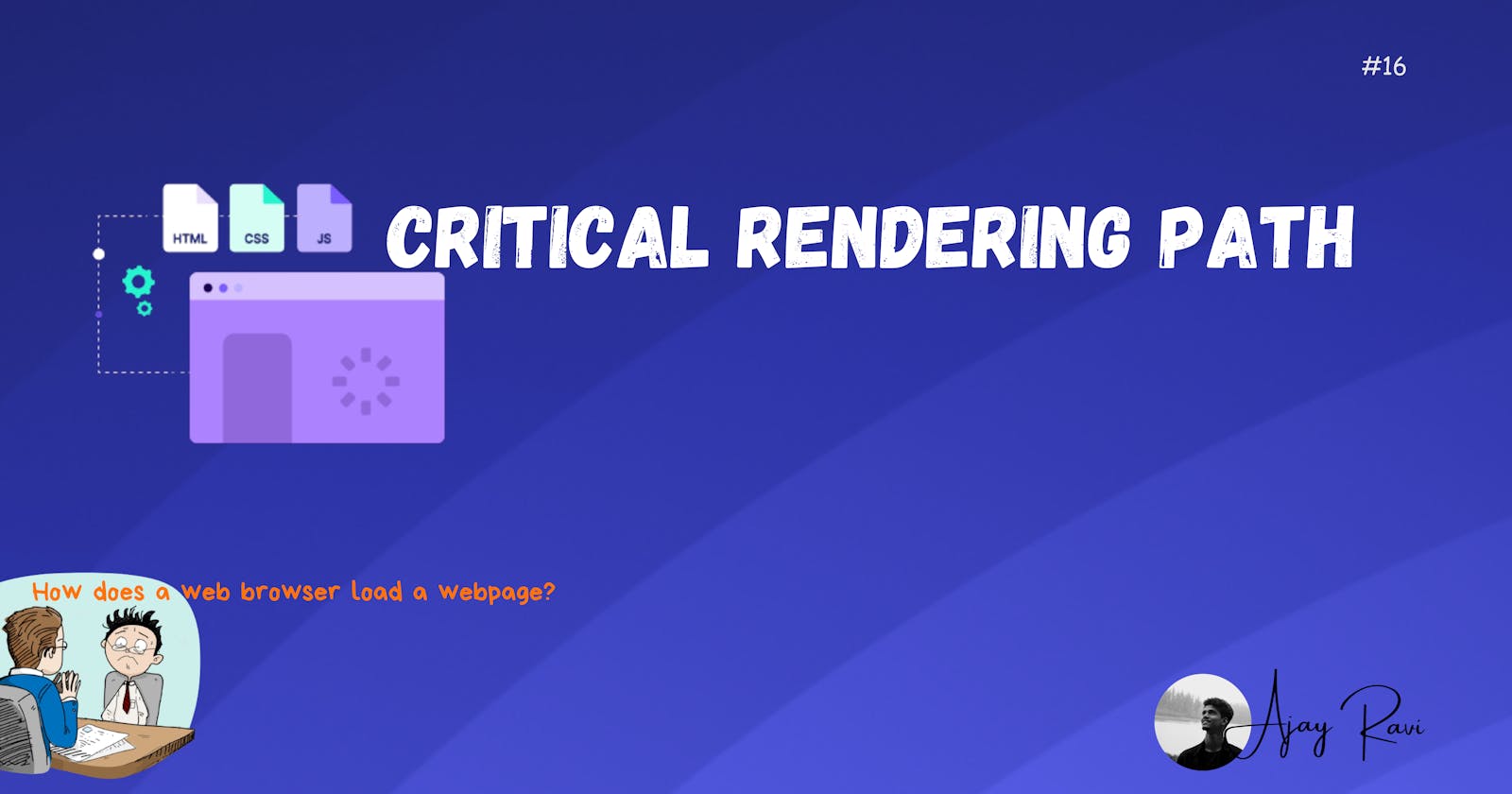Introduction
In today's fast-paced digital landscape, web performance optimization has become a paramount concern for businesses and developers alike. Users have come to expect blazing-fast loading times and seamless interactions when visiting websites and web applications. At the heart of delivering a swift and responsive user experience lies the Critical Rendering Path (CRP). In this comprehensive guide, we will explore the intricate details of the CRP, its impact on web performance, and practical strategies to optimize it effectively.
Understanding the Critical Rendering Path (CRP)
The Critical Rendering Path is the precise sequence of steps that a web browser follows to convert the raw building blocks of a web page—HTML, CSS, and JavaScript—into the pixels that are displayed on the user's screen. It is termed "critical" because it represents the minimum set of tasks required to render the initial content of a web page. Optimizing this path is crucial for achieving optimal render performance.
The CRP comprises several essential components:
1. HTML Parsing and DOM Tree Construction
The journey along the CRP begins with the parsing of the HTML document. As the browser processes the HTML, it constructs the Document Object Model (DOM) tree, representing the hierarchical structure of the webpage. The DOM tree forms the foundation upon which the rest of the rendering process relies.
2. CSS Parsing and Style Computation
While parsing HTML, the browser encounters references to external CSS resources. These stylesheets are then parsed to create the CSS Object Model (CSSOM). The browser combines the DOM and CSSOM to form the Render Tree, which contains only the elements that will be visually rendered. During this stage, the browser calculates the computed styles for each visible element, a crucial step for rendering.
3. Render Tree and Layout
The Render Tree is a combination of the DOM and CSSOM that represents the elements to be displayed on the screen. Layout, the next step, calculates the precise positioning and sizing of each element, taking into account the CSS styles and the document's structure. This calculation ensures that elements are correctly arranged on the page.
4. Painting
The final step in the CRP is painting, where the browser translates the computed styles and layout information into pixels on the screen. This process involves rendering text, images, backgrounds, and other visual elements, resulting in the complete visual representation of the webpage.
The Impact of CRP on Web Performance
Understanding the Critical Rendering Path is essential because it directly influences web performance. A slow CRP can lead to longer page load times, higher bounce rates, and a subpar user experience. Here's a closer look at how the CRP affects web performance:
- Perceived Performance
The time it takes to render critical content significantly influences how users perceive a website's speed. Users tend to notice when essential elements take too long to appear on the screen, potentially leading to frustration.
- Interactivity
A sluggish CRP delays the availability of interactive elements, such as buttons, forms, and navigation menus. Users may attempt to interact with the page before it's fully loaded, resulting in a less-than-ideal user experience.
- Search Engine Optimization (SEO)
Search engines consider page load speed as a ranking factor. A faster CRP can positively impact a website's search engine ranking, making it more discoverable to users.
Strategies for Optimizing the CRP
Now that we have a firm grasp of the Critical Rendering Path and its significance in web performance, let's explore practical strategies for optimizing it:
1. Minimize HTTP Requests
Reduce the number of external resource requests (e.g., stylesheets, scripts, images) to minimize the time spent waiting for resources to load. Combine multiple CSS and JavaScript files to reduce the number of HTTP requests.
2. Implement Lazy Loading
Employ lazy loading for non-critical resources like images and videos. This technique ensures that only the essential resources are loaded initially, improving page load times.
3. Inline Critical CSS
Inline critical CSS directly into the HTML to eliminate additional HTTP requests for styles. Reserve external CSS files for non-critical styles, reducing render-blocking resources.
4. Optimize JavaScript
Minimize and compress JavaScript files to reduce parsing and execution time. Utilize the async and defer attributes for script tags to prevent them from blocking rendering.
5. Image Optimization
Compress and resize images to reduce their file size while maintaining visual quality. Implement responsive images and consider using modern formats like WebP to serve efficient images based on the user's device.
6. Leverage Content Delivery Networks (CDNs)
Use Content Delivery Networks (CDNs) to serve assets from geographically closer servers. This reduces latency and speeds up resource retrieval.
7. Consider Server-Side Rendering (SSR)
For content-heavy pages, contemplate server-side rendering. SSR can deliver pre-rendered HTML to the client, reducing the browser's workload and enhancing perceived performance.
8. Implement Browser Caching
Set up browser caching to store static assets locally on users' devices, reducing the need to download them with each visit. Proper caching headers can significantly improve loading times.
9. Utilize Critical Rendering Path Tools
Leverage performance analysis tools such as Google's PageSpeed Insights or Lighthouse to identify and address bottlenecks in the CRP. These tools offer valuable insights into optimization opportunities.
10. Continuous Monitoring and Iteration
Regularly monitor your website's performance and iterate on optimization strategies to stay aligned with evolving best practices. Performance is an ongoing commitment, and staying up-to-date is essential for sustained success.
Conclusion
Optimizing the Critical Rendering Path is at the core of delivering a lightning-fast and efficient web experience for users. By comprehending the components of the CRP and implementing the best practices outlined in this guide, you can significantly enhance your website's performance. Remember that web performance optimization is a continual process, and staying informed about the latest techniques and tools is essential to maintaining a competitive edge in the digital realm. Start optimizing your CRP today, and watch your website load faster and delight your users like never before.
